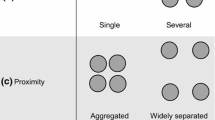Abstract
The use of “surrogate” design criteria (such as size or connectedness) to evaluate potential bioreserve network alternatives is attractive because they can be relatively straightforward to measure. However, to promote the persistence of a focal species, a higher level of biological detail may be used to derive specific design criteria for the species of interest. But just as for surrogate criteria, no single best criterion is likely to arise. Here, a set of mechanistic equations describing the dynamics of hawks and voles in a hypothetical landscape is used to derive design criteria for a reserve network. Multiobjective Integer Programming (MOIP) then identifies reserve network alternatives that reflect the tradeoffs between the objectives. When choosing from only five potential patches for inclusion in the network, in four of five cases a single design optimized the design objectives simultaneously. When choosing from ten patches, in all five cases there were conflicts between the objectives, but in two of five cases, there were optimal intermediate solutions along the tradeoff surface between the objectives. When resources allow, a more detailed description of the species of conservation interest may be used to develop reserve design criteria that are likely to promote persistence. MOIP can then be used to evaluate potential compromises between the criteria.
Similar content being viewed by others
References
N.E. Barrett and J.P. Barrett, Reserve design and the new conservation theory, in: The Ecological Basis of Conservation: Heterogeneity, Ecosystems, and Biodiversity, eds. S.T.A. Pickett, R.S. Ostfeld, M. Shachak and G.E. Likens (Chapman & Hall, New York, NY, 1997).
M. Bevers, J. Hof, D.W. Uresk and G.L. Schenbeck, Spatial optimization of prairie dog colonies for black-footed ferret recovery, Operations Research 45 (1997) 495–507.
T.J. Case, An Illustrated Guide to Theoretical Ecology (Oxford University Press, New York, NY, 2000).
R.L. Church, D.M. Stoms and F.W. Davis, Reserve selection as amaximal covering location problem, Biological Conservation 76 (1996) 105–112.
J.L. Cohon, Multiobjective Programming and Planning (Academic Press, New York, NY, 1978).
D.M. Debinski and R.H. Holt, A survey and overview of habitat fragmentation experiments, Conservation Biology 14 (2000) 342–355.
D.J.D Earn, S.A. Levin and P. Rohani, Coherence and conservation, Science 290 (2000) 1360–1364.
R.S. Etienne and J.A.P. Heesterbeek, On optimal size and number of reserves for metapopulation persistence, Journal of Theoretical Biology 203 (2000) 33–50.
I. Hanski, Single species metapopulation dynamics: concepts, models and observations, Biological Journal of the Linnean Society 42 (1991) 17–38.
A.N. James, K.J. Gaston and A. Balmford, Balancing the Earth's accounts, Nature 401 (1999) 323–324.
Lindo Systems, Lindo/386 5.3 (Lindo Systems, Chicago, IL, 1995).
R.H. MacArthur and E.O. Wilson, The Theory of Island Biogeography (Princeton University Press, Princeton, NJ, 1967).
K.A. McGuiness, Equations and explanations in the study of speciesarea curves, Biological Reviews of the Cambridge Philosophical Society 59 (1984) 423–440.
R.W. Mannan and E.C. Meslow, Bird populations and vegetation characteristics in managed and old-growth forests, northeastern Oregon, Journal of Wildlife Management 48 (1984) 1219–1238.
W.D. Newmark, Extinction of mammal populations in western North American national parks, Biological Conservation 64 (1995) 512–526.
J.R. Prendergast, R.M. Quinn and J.H. Lawton, The gaps between theory and practice in selecting nature reserves, Conservation Biology 13 (1999) 484–492.
K.D. Rothley, Designing bioreserve networks to satisfy multiple, conflicting demands, Ecological Applications 9 (1999) 741–750.
D. Simberloff, Flagships, umbrellas, and keystones: is single-species management passé in the landscape era?, Biological Conservation 83 (1998) 247–257.
M.L. Taper, K. Böhning-Gaese and J.H. Brown, Individualistic responses of bird species to environmental change, Oecologia 101 (1995) 478–486.
D. Van Vuren, Mammalian dispersal and reserve design, in: Behavioral Ecology and Conservation Biology, ed. T. Caro (Oxford University Press, New York, NY, 1998).
J.C. Williams and C.S. ReVelle, Applying mathematical programming to reserve selection, Environmental Modeling and Assessment 2 (1997) 167–175.
J.C. Williams and C.S. ReVelle, Reserve assemblage of critical areas: a zero-one programming approach, European Journal of Operational Research 104 (1998) 497–509.
Author information
Authors and Affiliations
Rights and permissions
About this article
Cite this article
Rothley, K.D. Dynamically-Based Criteria for the Identification of Optimal Bioreserve Networks. Environmental Modeling & Assessment 7, 123–128 (2002). https://doi.org/10.1023/A:1015653817019
Issue Date:
DOI: https://doi.org/10.1023/A:1015653817019




